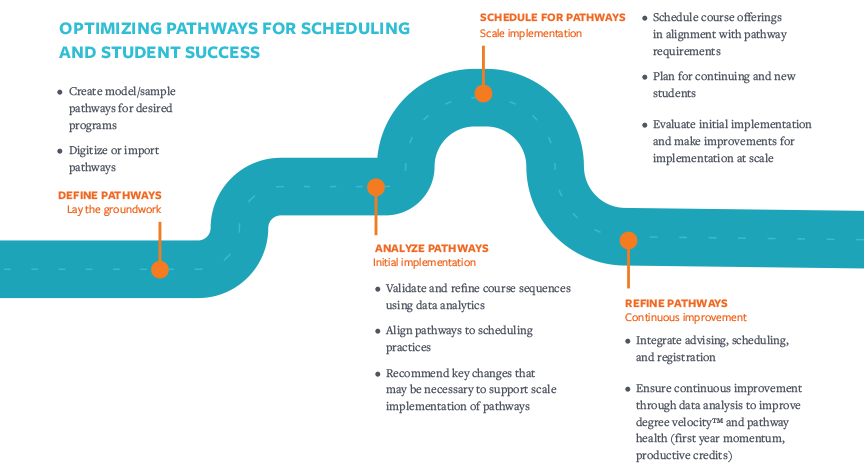
Pathways are known by many names. Simply defined, a pathway or degree map is a sequential list of courses required for a student to complete an academic program. It is a tool that can improve student success by streamlining course choice and it makes clear what courses students need to take and the order in which to take them.
Send it to Your Inbox!
Download your copy of The Power of Pathways. Fill out the form below and we will send it to your inbox!
All intentional plans of study should consider pre-requisites, co-requisites, developmental and test score requirements, and skills sets learned in various courses. Existing pathways offer opportunities to consider infrastructure, analyze student flow through pathways, and recommend key pathway changes to remove controllable barriers to student success.
Pathway design is the key to operationalizing your curriculum. Therefore, it’s important to evaluate how each pathway is organized and determine its aggregate effect on all pathways. For example, a pathway optimized for on-time student completion could include all morning classes to boost the success of a student who works in the evening. Likewise, a pathway prioritizing evening classes could make the difference between a working adult learner continuing their education or stopping out.
There is no single right approach to building pathways, and each institution may take a different strategy to its construction. Such a path may be structured or more flexible with either method offering support to academic and curricular infrastructure.
Used as the foundation of an annual schedule, intentional pathways help to ensure sustainable course offerings, maximize enrollment, and assist the institution in creating a stable and repeatable schedule to meet student demand.
This reliability reduces stress on students by eliminating choice paralysis and lessens scheduling uncertainty and workload on staff. Strong pathway design and implementation will also influence financial sustainability and the stewardship of instructional resources.
Institutions with a strong infrastructure in place can build and publish the course schedule in advance for an entire year. Annual schedules allow students to plan ahead into the future, and institutions to effectively and efficiently budget instructional resources on an annual basis – a win-win for all.
Some institutions are looking beyond the annual schedule to publish multiple terms in advance to aid student and institutional planning. This type of advanced planning allows students to envision the path for the entire degree program.
 Scheduling is a complex issue that impacts students and institutions. Determining and applying the leading indicators of student success allows an institution to be more proactive in moving the needle toward on-time completion.
Scheduling is a complex issue that impacts students and institutions. Determining and applying the leading indicators of student success allows an institution to be more proactive in moving the needle toward on-time completion.![]()
– Laura Kelly, VP of Solution Strategy, Ad Astra

DFW rates
Student cohorts
Course enrollment ratios
Historical schedules
Over time, proactive pathways help inform “where,” “when,” and “how” students are taking courses. Successful pathways help students graduate faster, reduce unnecessary credits, and streamline costs to obtain a degree.
Pathway guidance can also be paired with Ad Astra Predict software to analyze student progress and support further development of student-centric schedules for upcoming terms.

Ad Astra is higher education’s solution partner in managing the academic enterprise. Partnering with more than 500 colleges, universities, and systems nationwide, Ad Astra helps improve stewardship of instructional resources, streamline student access to courses, and accelerate student completions.